|
The conventional system for growing tomatoes for Thanksgiving is: “Tomato transplants should be in place by no later than August 15 if you expect to harvest a good crop before cold weather arrives in the San Antonio area. Hill Country gardeners should have planted by July 15th and South-of-San- Antonio gardeners should have their tomatoes transplanted by no later than September 15th.” All of these dates are determined by “typical weather patterns” experienced in these regions by vegetable growers.
(See Fall Direct Seeding and Transplanting Guide at:
http://aggie-horticulture.tamu.edu/archives/parsons/fallgarden/falldirect.html).
The pattern is generally: “Plant large transplants by no later than August 15; use heat-setting varieties; expect the first fall cool-down to occur a month after transplanting or around September 15; and this cool-down, especially of night-time temperatures, will cause blooms to set small fruit which will ripen in 50 to 60 days or by mid-to-late October.” If the cool-down does not occur until October, usually the first hard frost will kill plants before tomatoes can be ripened on the vine.
Unfortunately, the conventional recommendations are ignored by a majority of gardeners until the first fall cool-down occurs around September 15. That is when enjoyable weather peaks the gardening hormones and gardeners flock to nurseries to search for transplants of their vegetable favorites – tomato being number one. This is the perfect time to plant the cold-tolerant, cool-season transplants such as broccoli, cauliflower, Brussels sprouts and cabbage but planting of tomatoes is generally discouraged unless extraordinary cold protection is to be used in December.
This fall, horticulturists in San Antonio are going to try to help tomato lovers “beat the odds” of a crop failure of late transplanted tomatoes. New, fast-maturing, heat-setting varieties of tomatoes combined with some recommended cultural practices are going to be our “secret weapons”. We have “armed” local retail participating nurseries with “supplies” needed to make this a successful “mission”. Some may refer to it as “Mission Impossible” and it may end up being just that if we don’t get the weather conditions we need to mature this late setting fruit. What weather do we need beginning on Saturday, September 17? We basically need to have hot days (in the high 80’s or low 90’s) and cool nights (mid-to high 70’s) from the day you get your transplants at your favorite participating nursery until mid-October. Those are the conditions for maximum plant growth, optimum fruit set and optimum ripening conditions . Tomatoes usually take 50 days from fruit set to the harvest of ripe fruit. That maturity length is for large fruited tomatoes (Celebrity, Sun Pride, Tycoon, etc.). If however, smaller fruit-size varieties are used, the time interval from fruit-set to harvest of ripened fruit will be shortened. It would also help our overall yields if we could avoid having a hard (below 32 degrees F. for several hours) freeze until mid-December.
“If you decide to accept this mission”, variety selection and watering is the key to success on this better-late-than-never fall-planting tomato experiment. For the tomato, we have chosen the fastest maturing, medium size, longest storage tomato ever put on the market by the Texas AgriLife Extension Service. It is named ‘Surefire’ and was the first Texas’ SuperStar tomato introduced during Fall, 1992. ‘Surefire’ was judged to be the meatiest tomato and all agreed it would be the best for salsas, sauces and long-storage. Transplants of the ‘Surefire’ tomato variety should be planted as they have been proven to set and ripen fruit the fastest. Smaller determinate tomatoes such as ‘Surefire’ are more productive per square foot and should be planted two feet apart in the row or two plants per whiskey-size container (For instructions about growing in containers, see:
http://aggie-horticulture.tamu.edu/archives/parsons/misc/container.html).
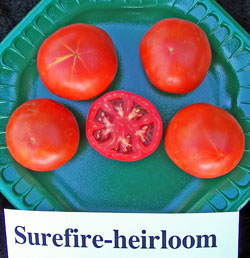
Surefire-heirloom Tomato.
|
Regardless of how good the varieties and transplants are, if prior soil preparation is not adequate, you will be doomed to failure before you begin. If your garden has been deserted during this prolonged dry period, you must pre-irrigate to insure adequate soil moisture throughout the entire soil profile before you plant the first transplant. This can be accomplished by thoroughly watering (at least an hour) twice – 5 days apart. After the second watering, wait another 5 days, then dig and/or till the area. If weeds and/or grass are present, spray the entire garden area with a glyphosate (Roundup) herbicide (see safety factors at:
http://www.plantanswers.com/roundup.htm) after the first watering and before cutting/removing the weeds and/or grass. A week later you can remove the weeds/grass, dig or till, fertilize with 5 pounds of a 19-5-9 slow-release fertilizer per 100 square feet (10 feet by 10 feet) and safely plant your fall garden. A slow-release fertilizer such as Osmocote for containers should be used in all potting mixes regardless of label claims of fertility being included. Transplants should be watered in thoroughly at planting with a water-soluble fertilizer (Miracle Grow, Rapid Grow, Peters 20-20-20, Hasta Gro, etc.). Water-soluble fertilizer should be used EVERY time your vegetables are watered in a container in addition to having a slow-release fertilizer in the potting mix. The best way to insure success with this plan is to use drip irrigation on ALL fall planted crops – ESPECIALLY WITH DROUGHT RESTRICTIONS. More information about drip irrigation can be found at:
http://www.plantanswers.com/garden_column/july04/2.htm
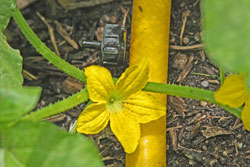
Successful Fall gardening is easier when using drip irrigation.
|
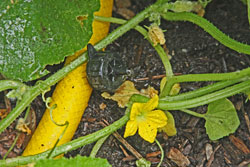
Fall Cucumbers respond to the targeted water of a drip system.
|
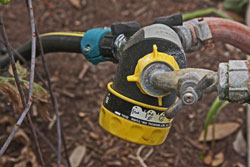
Drip systems can be automated.
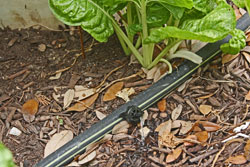
Fall cole crops respond well to drip irrigation.
|
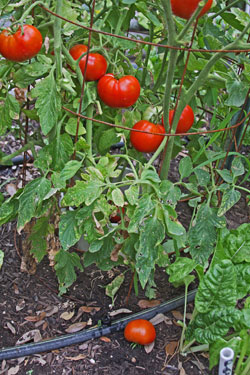
Establishment and an abundant harvest of fall tomatoes depends largely on drip irrigation.
|
The remedy for insect damage and contamination as well as to stimulate and enhance fruit ripening is a physical barrier of a spunweb translucent, fabric-like material. When you transplant tomatoes into the garden or a growing container, immediately install concrete reinforcing wire cages or LARGE cages purchased from a nursery. Cages are nothing more than cylinders made of reinforcing wire, hog wire or similar material to support the plant and keep the fruit off the ground. The cage also serves as a support structure for the translucent, fabric-like material known as spunweb. Adequate anchorage is essential for cages covered with spunweb during windy periods. The most commonly available spunweb product plant cover in local nurseries is the DeWitt Plant & Seed Guard (10 feet by 12 feet sheet costs $13) which is a plant protection (from cold, insects, wind, hard rain, etc.) blanket or floating row cover.
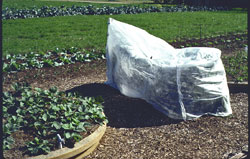
Cover plants and fruit with clear plastic for cold protection and fruit ripening.
|
Plants covered with this spunweb never have to be uncovered. Spunweb will never overheat plants since the temperature inside the fabric-like material will not exceed 15 degrees F. above the daytime high temperature. Spunweb used for the fall crop, will not overheat plants and seems to act as a shading cloth which may stimulate earlier fruit set. You may wonder if plants will set fruit when covered with a spunweb product since no bees or insects are able to enter. Tomatoes, peppers and eggplants are 85 percent self-pollinated; that is, they don't need movement of pollen by insects. If you want to insure adequate pollination, vigorously shake the covered cages every day after bloom begins or thump bloom clusters daily with your finger.
Protect tender transplants as soon as possible from virus-carrying insects and environmental adversities with the covered cages. The larger a plant is before an infection or infestation occurs, the more productive the plant will be, and conversely. To protect seedlings from birds or other varmints and vine crops (such as broccoli and cole crops) from leaf-eating caterpillars, cover them with a spunweb product. You can also use spunweb products to "vine ripen" fruit since the plants can be completely surrounded and covered until ripening occurs. As previously mentioned, the ambient temperature is warmer in a spunweb covered structure. This additional warmth will hasten the fruit ripening process.
Spunweb products can be found in local nurseries or ordered directly from the manufacturer through the mail. One address is: Indeco Products Incorporated, P.O. Box 865, San Marcos, Texas 78666 Telephone: 512-396-5814 or 1-888-246-3326; Indeco Products sells the spunweb product called Grow-Web (12 feet wide by 16 feet long sheet costs $23 plus a small shipping fee). Contact them for longer sheets at a considerable saving.
Then sit back and wait for the Thanksgiving and Christmas feasts. Cold protection techniques are described in November articles at:
http://plantanswers.com/garden_columns.htm (see:
http://plantanswers.com/garden_column/111001/111001.htm) and
http://plantanswers.com/calvin_finch_articles.htm.
When temperatures cool, fruit will require longer ripening on the plants. To stimulate and enhance fruit ripening, we are recommending that all tomatoes be caged and completely wrapped in a spunweb product at planting and all stems be kept within the cage structure. All plants and fruit should be wrapped OVER (ON TOP OF) THE SPUNWEB with clear plastic on the first of November. Leave the top one-fourth of the plastic open. This flap will be used to completely cover the caged plants when the first hard frost occurs in early December. A supplemental heat source (heat lamp or such) will need to be added to the plastic and spunweb covered plants for long duration (several hours), hard (below 30 degrees F.) freezes if you expect to vine-ripen tomatoes and keep plants alive. Anchor well all covered structures in anticipation of windy-weather cold fronts, i.e., “Blue Northers”.
To “force ripen” tomato fruit, harvest the fruit at first blush or pink instead of leaving them on the plant to ripen fully. A tomato picked at first sign of color and ripened at room temperature will be just as tasty as one left to fully mature on the vine. Never refrigerate tomatoes picked immature. Place them in a single layer at room temperature and allowed them to develop full color. When they are fully ripe, place them in the refrigerator several hours before eating. Those handled in this manner will be of high quality and full flavor.
How do you tell when a green tomato harvested early to prevent freeze damage will ever turn red and ripen? This can simply be done with a sharp kitchen knife. Harvest a tomato typical of the majority of green tomatoes on your plants. Look at size but pay particular attention to fruit color. Slice through the center of the tomato. Closely examine the seed within the fruit. If the seeds are covered with a clear gel which causes them to move away from the knife, then that fruit will eventually turn red and ripen. If the seeds are cut by the knife then those fruit will never properly ripen. Compare the color and size of the tested fruit when harvesting tomatoes on your plants. Most similar fruit will eventually ripen and turn red. A complete description with visuals can be seen at:
http://www.plantanswers.com/Articles/RipeningOfGreenTomatoes.asp
Use less mature fruit to make chow chow or relishes. Recipes can be found at:
http://www.plantanswers.com/Recipes/tomrec.html and
http://www.plantanswers.com/condiments.htm
Gardeners, if this plan fails, area horticulturists will disavow any knowledge of this “operation”. However, if it succeeds in putting garden-fresh tomatoes on your Thanksgiving and Christmas table, we will definitely avow EVERYTHING that happened!
|



